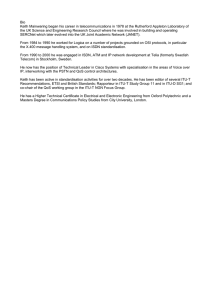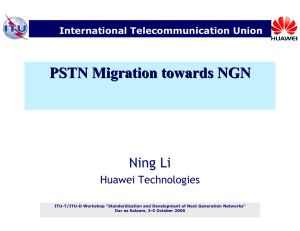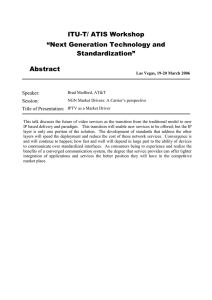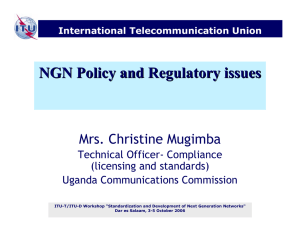NGN Services Keith Mainwaring Technical Leader, Cisco International Telecommunication Union
advertisement
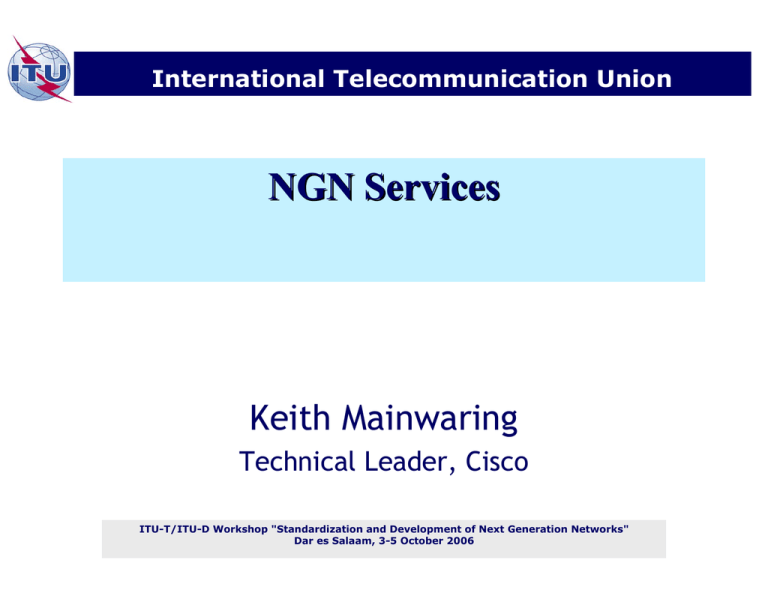
International Telecommunication Union NGN Services Keith Mainwaring Technical Leader, Cisco ITU-T/ITU-D Workshop "Standardization and Development of Next Generation Networks" Dar es Salaam, 3-5 October 2006 ITU-T’s Definition of NGN o o o o o o o o o o o o o o Packet-based transfer Separation of control functions among bearer capabilities, call/session, and application/service Decoupling of service provision from transport, and provision of open interfaces Support for a wide range of services, applications and mechanisms based on service building blocks (including real time/streaming/non-real time services and multi-media) Broadband capabilities with end-to-end QoS and transparency Interworking with legacy networks via open interfaces Generalised mobility Unfettered access by users to different service providers A variety of identification schemes which can be resolved to IP addresses for the purposes of routing in IP networks Unified service characteristics for the same service as perceived by the user Converged services between Fixed and Mobile networks Independence of service-related functions from underlying transport technologies Support of multiple last mile technologies Compliant with all Regulatory requirements, for example concerning emergency communications and security/privacy, etc. ITU-T/ITU-D Workshop "Standardization and Development of Next Generation Networks" Dar es Salaam, 3-5 October 2006 2 NGN Release 1 Services o Multimedia services o PSTN/ISDN Emulation o PSTN/ISDN Simulation o Data communication services o Public interest aspects NOTE: NGN is not intended to preclude access to the Internet. ITU-T/ITU-D Workshop "Standardization and Development of Next Generation Networks" Dar es Salaam, 3-5 October 2006 3 Multimedia Services • • • • • • • • • Real-time Conversational Voice Messaging, e.g. IM, SMS, MMS Push to talk over NGN Point-to-Point interactive multimedia Collaborative interactive communication Content delivery Push-based services Broadcast Services (ie. Multicast) Hosted and transit services for enterprises (IP Centrex, etc.) • Information services • Location-based services • Presence and general notification services ITU-T/ITU-D Workshop "Standardization and Development of Next Generation Networks" Dar es Salaam, 3-5 October 2006 4 Data Communication Services • Virtual Private Network (VPN) • Existing data services • Data retrieval services • Online services • Sensor Network services • Remote control/tele-action services ITU-T/ITU-D Workshop "Standardization and Development of Next Generation Networks" Dar es Salaam, 3-5 October 2006 5 Public Interest Aspects • Emergency Communications (including support of Early Warning) • Support for users with disabilities • Lawful Interception • Service unbundling • Number portability • Network or Service provider selection • Prevention of unsolicited bulk telecommunications • Malicious communication identification • User identifier presentation and privacy ITU-T/ITU-D Workshop "Standardization and Development of Next Generation Networks" Dar es Salaam, 3-5 October 2006 6 ETSI TISPAN Release 1 Services o Multimedia Telephony with PSTN/ISDN Supplementary Services o Messaging o Videotelephony over NGN o Presence Service ITU-T/ITU-D Workshop "Standardization and Development of Next Generation Networks" Dar es Salaam, 3-5 October 2006 7 PSTN Emulation & Simulation o o PSTN/ISDN Emulation • Mimicking a PSTN/ISDN network from the point of view of legacy terminals (or interfaces) by an IP network, through a gateway. All PSTN/ISDN services remain available and identical (i.e. with the same ergonomics); such that end users are unaware that they are not connected to a TDM-based PSTN/ISDN. • Softswitch approach: Monolithic architecture • IMS approach: Re-use (all or part) of the IMS functional architecture to specify the internal structure. Common control platforms, and enables new voice services for all types of subscribers. PSTN/ISDN Simulation • The provision of PSTN/ISDN-like services to advanced terminals (IPphones) or IP-interfaces. There is no strict requirement to make all PSTN/ ISDN services available or identical, although end users expect to have access to the most popular ones, possibly with different ergonomics. ITU-T/ITU-D Workshop "Standardization and Development of Next Generation Networks" Dar es Salaam, 3-5 October 2006 8 ETSI TISPAN NGN Release 2 o Enhancements to existing capabilities o IPTV • Transport stratum impact – DVB IPTV service • Service stratum interworking • IMS-based IPTV o Fixed Mobile Convergence • CS Mobile voice service and WiFi with public residential VoIP service • CS Mobile voice service and WiFi with IP centrex service • CS Mobile voice service and WiFi with IP PBX • PS Mobile voice service and WiFi with public residential VoIP service • Use case for Voice Continuity • Roaming and handover scenarios ITU-T/ITU-D Workshop "Standardization and Development of Next Generation Networks" Dar es Salaam, 3-5 October 2006 9 Uses of NGN & ICT – Mr. Norio Wada (CEO, NTT) “First some background: right now Japan is in a population crisis. The birthrate is shrinking. By 2015, a quarter of the population will be 65 or older. This will rise to one-third by 2050. As the productive population declines and the demand for medical care goes up, the NGN and ICT will make important contributions. One area will be in remote medical diagnosis and monitoring. For example, broadband network enables pathologists in a large hospital to diagnose patients in distant areas. It can also connect the homes of sick and elderly people to a nursing center. This type of system should reduce the cost of nursing care. The second area of application is for a safe and secure society. As an example, we’ve developed an emergency notification system to help citizens in a disaster. This system is already used by some governments for disaster prevention and management. The third area is enhancing productivity and work opportunities. One way this can happen is using broadband for remote working. A specific example is a virtual factory of digital maps, in which workers at home make and maintain digital maps. The NGN and ICT also support new types of products and services. Right now we’re involved in trials for a digital cinema service. Super-high-definition video, with 8 Mega-pixel resolutions, is delivered over an optical network from Hollywood to theaters in Tokyo and Osaka.” Source: “The NTT Group’s Direction and Expectations for the Role of ITU-T in the Age of Ubiquitous Broadband Communication” http://www.itu.int/ITU-T/50/programme.html ITU-T/ITU-D Workshop "Standardization and Development of Next Generation Networks" Dar es Salaam, 3-5 October 2006 10 Bandwidth % Current Bandwidth Consumption & Service Mix Currently covered by IMS standards Service Service Revenue Revenue Potential Potential Baseline Customer Expectation, Control, Efficiency Issues SIP Multimedia Messaging IM, SMS, MMS Video/IPTV Business IP Web—P2P, HTML Includes Non-SIP Controlled Services: SIP Controlled Services: Infinite apps, content, URL Known applications Hosted and “Over The Top” services Known subscribers Numerous devices and access Known device-types Workshop "Standardization and Development Wide variety of protocolsof Next Generation Networks" LimitedITU-T/ITU-D protocol set Dar es Salaam, 3-5 October 2006 11 Future Services e-Health o e-Education o e-Commerce o e-Security o e-Government Not just a new voice network o ITU-T/ITU-D Workshop "Standardization and Development of Next Generation Networks" Dar es Salaam, 3-5 October 2006 12
